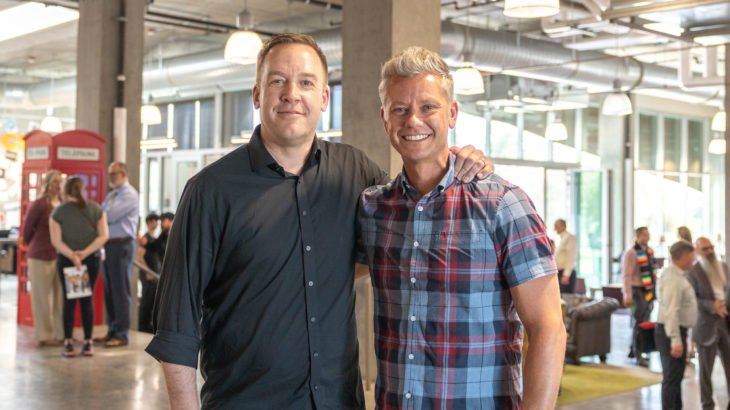In 1999, University of Utah student Stuart Fetzer had a vision – to start a business plan competition modeled after competitions offered at MIT and Stanford. Along with Seth Shaner, Fetzer created the Utah Entrepreneur Challenge (UEC), a business-plan competition for college students across the state of Utah.
Fetzer and Shaner both graduated from the U in 2001, Fetzer with a BS in material science engineering and Shaner with a BS in finance. They shared their experiences starting UEC.
How did you get involved in student leadership at Lassonde?
Shaner: When I came to the U in 1999, I wanted to finish the last two years of my bachelor’s degree. The first day I was on campus, I went to the office of Jack Brittain, the dean of the business school. He told me about this engineering student, Stuart Fetzer, who wanted to start a business plan competition. As soon as I left Jack’s office, I called Stuart and told him I was coming over. Stuart was hesitant and didn’t necessarily want me to come over that night, but he gave me his address, and I drove to his house. We hit it off and I joined him in starting the Utah Entrepreneur Challenge.
Why did you want to get involved?
Fetzer: I got involved because, even though I was an engineering student, I was excited about entrepreneurship and wanted to make an impact.
What was your involvement with UEC?
Fetzer: I am the original founder of the UEC. It was my idea to create the competition. I wrote the first conceptual business plan and raised the first prize money. I designed the competition and managed the UEC as its chairman for the first two years of its operation.
Shaner: I was Stuart’s No. 2 in starting the Utah Entrepreneur Challenge. I wrote the business plan for the University Venture Fund and started working through legal issues with the university.
What was the inspiration behind UEC?
Fetzer: I was interested in starting my own business and needed help learning how to do it. I decided that as I was learning how to do it, I could help others do it as well. MIT’s entrepreneurship program and Stanford’s program were both instrumental in my early design of the UEC.
What was the process to establish UEC?
Fetzer: Seth Shaner was very helpful as a partner in shaping the structure of the UEC. As we perfected the business model (I probably re-wrote the business plan 6 or 7 times), we often acted with boldness because of our naiveté. I published the values of the competition prize money before I had even raised a single dollar. I published that we had an amazing educational and speaking series before I had gotten a single speaker. But we made things happen out of sheer will many times. And out of fear of failure.
Shaner: During that first year, I attended a lunch with alumni on the National Advisory Board. I sat next to an alumnus named Geoff Woolley. I told him about what we were doing with UEC and the speaker series we had started. He then suggested that we create a student-run venture fund. I told him that was a great idea but that we’d only do it if he would be willing to support us as a guide and resource. He agreed.
What did the early days look like for UEC?
Shaner: In the early days, I spent many nights working very late or all night to make the UEC work. When the classrooms at the business school closed at 10 p.m., I would move to the law library. When it closed at midnight, I had to move to the main campus library. When that closed (at I think 2 a.m.), I was out of luck.
Fetzer: Sometimes our team was very discouraged in the first year of the competition. We had some events where very few people showed up. But, about 200 people showed up for the final awards ceremony in the first year of the competition.
What were the initial key features of UEC?
Fetzer: We had a speaker series where each event helped students learn how to write a business plan. We received hard-copy business plan submissions the first year and digital submissions the second year. We provided students with a business plan outline and required submission of an executive summary to get past the first round of judging and an entire business plan to become a finalist/winner. We had a high-profile speaker at the awards ceremony and offered a full meal.
What was the first UEC competition like?
Shaner: That first year was a big success, and we had amazingly talented students all over campus applying to be part of our team. This was all way before scholarships or stipends, so the glory and the payoff were intrinsic. Nevertheless, we were swamped with the brightest.
How is UEC different currently from when you participated?
Fetzer: I believe that the UEC is organized much better now than it was in the beginning because it is now part of an entire entrepreneurial ecosystem. Students understand the purpose of the UEC much better now and are coming to the table with some incredible ideas and institutional support.
What is it like seeing UEC grow into what it is now?
Fetzer: I’m so excited to have created what I did, but I cannot claim anything more than having been in the right place at the right time. The fact that the UEC is still here 25 years later is not because of anything I did, but because of the incredible support that Pierre Lassonde, Troy D’Ambrosio, Jack Brittain, Taylor Randall, Heidi Woodbury, and countless other staff members and students have given to the cause since then.
Shaner: I am happy that we created enormous value with these programs with students, the university, and the community.
Learn more about the Utah Entrepreneur Challenge at lassonde.utah.edu/uec/.



